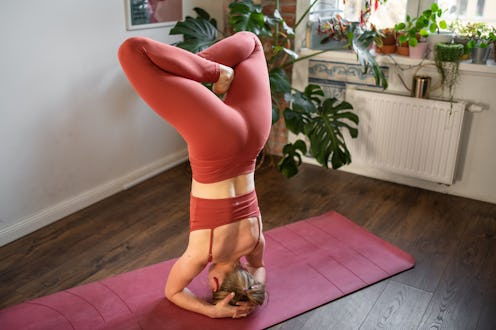Fitness
The Benefits Of Yoga Inversions Might Surprise You
Flip your flow onto its head.

While a lot of yoga postures are about reaching up to the sky or down towards your toes, don’t forget to also stand on your head. Inversion poses are always impressive to look at — see: Miley Cyrus’ headstands and Beyoncé’s backbends — but instructors say they’re also good for you.
Inversion poses include any and all yoga postures that turn you upside down so that your head is lower than your heart, says Dr. Brian Gans, M.D., a double board-certified physician and yoga teacher. There’s a wide range of inversions to try, from the beginner-friendly downward dog all the way up to headstands that require more strength, balance, and mobility.
Whichever move you choose, trust that it’s beneficial to be upside down. For one, this position boosts circulation by encouraging blood from your legs and pelvis to flow back towards your heart, says Josie Schweitzer, a certified yoga teacher and two-time Lululemon ambassador. “This boosted circulation nourishes cells and may help drainage in the lymphatic system,” she tells Bustle. Plus, if nothing else, it feels good after traveling or sitting for long periods of time.
According to Schweitzer, inverted yoga poses are great for mental clarity, too. “By reversing the body's orientation, we also shift perspective,” she says. “A new vantage point creates mental openness and may provide an energizing mood boost.” Flipping upside down also calms the nervous system by stimulating the vagus nerve, she adds, which in turn slows your heart rate and reduces your fight-or-flight response.
Another perk? Physically, an upside-down yoga pose can help realign and decompress your spine. “Gravity compresses the spine all day long when upright,” Schweitzer says. “Inversions gently lengthen and realign the vertebrae, relieving pressure on the discs and nerves.”
If you’re down to give some a try, here are some yoga inversions that trainers recommend.
1.Downward Dog
Downward dog is a foundational yoga pose, and one that’s likely already a part of your sequence. As you lower your head and lift your hips to the sky, you’ll get all the benefits of an inversion, says Gans.
- Start on all fours.
- Place your hands under your shoulders and your knees under your hips.
- Curl your toes under so the balls of your feet are touching the ground.
- Exhale and lift your knees off the floor and push your hips to the ceiling to create an inverted V shape.
- Straighten your knees by pushing your heels to the floor.
- Keep your arms straight.
- Hold for five to 10 breaths.
2. Legs Up The Wall
Legs up the wall is a good one to try whenever you need to get rid of swelling in your legs. It’s also super relaxing and helps improve circulation, says Gans.
- Place a yoga mat next to a wall. (You can also do this in bed.)
- Sit on the mat with one hip touching the wall and your legs extended.
- As you lean back onto your mat, rotate your body and bring your legs up onto the wall.
- Keep your back flat on your mat.
- Scoot your hips closer and rest your legs against the wall.
- Keep your legs straight and your arms relaxed by your sides.
- Hold the pose for five to 10 minutes, focusing on deep, even breathing.
3. Supported Bridge Pose
According to Schweitzer, this gentle inversion will help decompress your spine.
- Grab a yoga block.
- Lie on your back with your knees bent and feet hip-distance apart on the floor.
- Inhale and lift your hips up.
- Slide the yoga block under your sacrum at the lowest part of your back.
- Rest your arms alongside your body with palms facing up.
- Hold this inversion for five to 10 breaths.
4. Plow Pose
Plow pose gets you upside down in a posture that also stretches your shoulders and lengthens the spine.
- Begin on your back with your feet and arms extended, palms face down.
- On an inhale, lift your legs and hips towards the ceiling with your legs straight.
- Slowly extend your legs over your head, aiming to get your feet behind your head onto your mat.
- If your feet don’t reach the ground, you can support your back with your hands.
- Keep your legs as straight as possible as you align your hips over your shoulders.
- Hold for five to 10 breaths.
5. Headstand
Deanna Ainsworth, the director of yoga education for Hot 8 Yoga, suggests slowly building up to the ultimate inversion pose — a headstand. This move strengthens your core and shoulder muscles, increases blood flow, and enhances balance and focus.
- Start in a kneeling position.
- Interlock your fingers and place the crown of your head on the ground.
- Straighten your legs and lift your hips until your body is in a straight line.
- Engage your core.
- To modify, use a wall for support your keep your knees bent.
- Hold for 30 seconds to one minute.
Studies referenced:
Anheyer, D. (2022). Yoga for treating low back pain: a systematic review and meta-analysis. Pain. doi: 10.1097/j.pain.0000000000002416.
deVries, HA. (1985). Vagotonic effect of inversion therapy upon resting neuromuscular tension. Am J Phys Med. 1985 Jun;64(3):119-29. PMID: 3159265.
Kondrashova, T. (2019). Dynamic assessment of cerebral blood flow and intracranial pressure during inversion table tilt using ultrasonography. J Neurol Sci. 2019 Sep 15;404:150-156. doi: 10.1016/j.jns.2019.07.033. Epub 2019 Jul 31. PMID: 31398694.
Mendelow, A. D. (2021). Lumbar disc disease: The effect of inversion on clinical symptoms and a comparison of the rate of surgery after inversion therapy with the rate of surgery in neurosurgery controls. Journal of Physical Therapy Science, 33(11), 801-808. https://doi.org/10.1589/jpts.33.801
Sources:
Dr. Brian Gans, M.D., double board-certified physician, yoga teacher
Josie Schweitzer, certified yoga teacher, two-time Lululemon Ambassador
Deanna Ainsworth, director of Yoga Education for Hot 8 Yoga